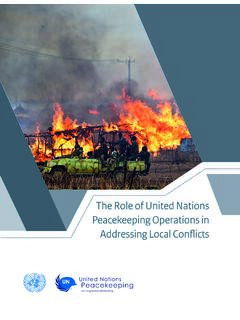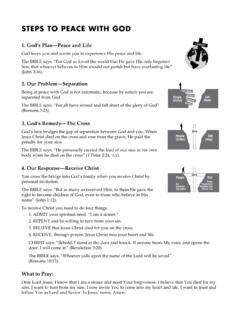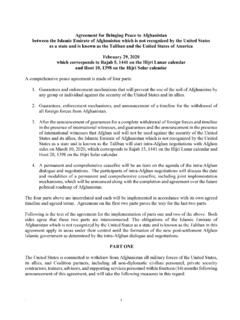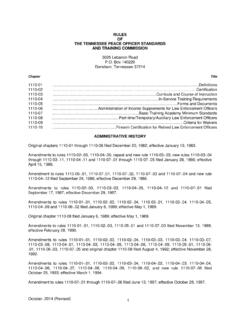Transcription of The Protection of Civilians in United Nations Peacekeeping
1 UNCLASSIFIED 1 United Nations Department of peace Operations Ref. Policy The Protection of Civilians in United Nations Peacekeeping Approved by: USG DPO Effective date: 1 November 2019 Contact: DPO/DPET/PBPS/ Protection of Civilians Team Review date: 1 November 2022 UNCLASSIFIED 2 DPO POLICY ON The Protection of Civilians in United Nations Peacekeeping Contents: A. Purpose B. Scope C. Rationale D. Policy Background Definition Operational Concept Implementing the Mandate E. Roles and Responsibilities Performance and Accountability F. Terms and Definitions G. References H.
2 Monitoring and Compliance I. Contact J. History ANNEX A. Roles and Responsibilities A. PURPOSE 1. The purpose of this policy is to provide the conceptual framework, guiding principles and key considerations for the implementation of Protection of Civilians (POC) mandates by United Nations (UN) Peacekeeping operations and related support by the Department of peace Operations (DPO). Forthcoming guidance materials, including a POC handbook, will provide further practical guidance on the implementation of POC mandates, particularly in various specific contexts. B. SCOPE 2. Compliance with this policy, under the overall authority of the Head of Mission, is mandatory for all UN personnel: civilian and uniformed, working in UN Peacekeeping operations with a mandate to protect Civilians .
3 civilian personnel include all staff members, seconded civilian personnel, United Nations Volunteers, civilian experts on mission, individual contractors and consultants. Uniformed personnel include all members of the UNCLASSIFIED 3 military, police and corrections components, whether contracted or seconded. 3. This policy also applies to personnel in DPO under the authority of the Under-Secretary-General (USG) in their support to the Protection of Civilians by UN Peacekeeping operations. 4. While the POC mandate in UN Peacekeeping often intersects with many other mandated tasks including support to peace processes, promotion and Protection of human rights, building the rule of law and security, specialized mandates on child Protection and conflict-related sexual violence (CRSV) and facilitating the delivery of humanitarian assistance this policy applies specifically to the mandate to protect Civilians .
4 Nonetheless, the implementation of mandated tasks should be aligned and complementary. C. RATIONALE 5. In 1999, the United Nations Security Council passed its first resolution on the Protection of Civilians (S/RES/1265, 1999) and, for the first time, gave a Peacekeeping operation the mandate to take necessary action to protect Civilians under imminent threat of physical violence (S/RES/1270, 1999 on the United Nations Mission in Sierra Leone, UNAMSIL). Requests from the Special Committee on Peacekeeping Operations (A/64/19, 2010) and the Security Council (S/RES/1894, 2009) recognized the need for operational guidance to inform the implementation of POC mandates. This led to the development of the Operational Concept on the Protection of Civilians in United Nations Peacekeeping Operations in 2010 and the first DPKO/DFS Policy on the Protection of Civilians in United Nations Peacekeeping in 2015.
5 These documents drew on operational experience and have formed the core of doctrine and guidance on the Protection of Civilians in UN Peacekeeping . 6. Since 2015, UN Peacekeeping practice on the Protection of Civilians has continued to evolve to reflect evolving operational and contextual realities and to develop new approaches to effectively implement the POC mandate. This updated policy therefore incorporates best practices and lessons learnt from Peacekeeping operations, developments in Security Council practice and the recommendations of internal and external reports and investigations into the Protection of Civilians in UN Peacekeeping . It also reflects the recommendations of the General Assembly Special Committee on Peacekeeping Operations and broader commentaries and recommendations on UN Peacekeeping , such as the High-Level Independent Panel on peace Operations (S/2015/446), the Report on Improving Security of United Nations Peacekeepers (2017) and the Declaration of Shared Commitments on Action for Peacekeeping (2018).
6 7. Applicable to UN Peacekeeping operations for which the Security Council has provided Protection of Civilians mandates, this policy promotes consistency in approach to the Protection of Civilians . At the same time, it also recognizes the varied operational contexts faced by UN Peacekeeping operations and the requirement for flexibility to respond to changing environments and the different resources available across the lifecycle of a mission. It also aims to clarify and operationalise the Protection of Civilians as mandated by the Security Council by promoting a comprehensive and integrated approach. 8. For the purposes of this policy, a comprehensive approach to the Protection of Civilians is one which takes into account and addresses the range of factors which influence and underpin threats to Civilians in both the short- and long-term, including political, security and economic factors.
7 Such an approach recognizes that the Protection of Civilians requires the coordination of the full range of capabilities available to the mission to achieve UNCLASSIFIED 4 strategic Protection objectives. An integrated approach to the Protection of Civilians requires the combined effort of all mission components: civilian , police and military, and where relevant and appropriate, coordination with other UN actors including the UN Country Team (UNCT). Integrated analysis and planning is critical to ensure that the mission is able to implement a comprehensive approach to POC. 9. This policy clarifies the roles and expectations of relevant mission components so that POC can be fully integrated into mission planning and activities. It also stresses the requirement for both institutional and individual accountability for effective implementation of POC mandates.
8 10. This policy supersedes the 2015 DPKO/DFS Policy on the Protection of Civilians in United Nations Peacekeeping and its 2018 Addendum on Accountability for Implementation of the Protection of Civilians Mandates, the 2010 Operational Concept on the Protection of Civilians in Peacekeeping as well as the DPKO/DFS Framework for Drafting Comprehensive Protection of Civilians Strategies. 11. Policies and guidelines to be read in conjunction with this policy include: DPKO/DFS Guidelines on Protection of Civilians : Implementing Guidelines for Military Components of United Nations Peacekeeping Missions ( ); DPKO/DFS Guidelines on the role of United Nations police in Protection of Civilians ( ); DPKO/DFS/DPA Policy on Child Protection in United Nations peace Operations ( ); DPKO/DFS Policy on Gender Responsive United Nations Peacekeeping Operations ( ); Human Rights due diligence policy on UN support to non- United Nations security forces (HRDDP) (A/67/775-S/2013/110); OHCHR/DPKO/DPA/DFS Policy on Human Rights in UN Peacekeeping Operations and Political Missions ( ); other documents referenced in Section G below and future guidance documents on POC.
9 D. POLICY Background 12. UN Peacekeeping is an instrument which provides security, political and peacebuilding support to help countries make the difficult transition from conflict to peace . Noting that Civilians continue to account for the vast majority of casualties in situations of armed conflict, the Security Council has passed regular resolutions on the Protection of Civilians , children and armed conflict (CAAC) and CRSV. These resolutions have contributed to the role of Peacekeeping operations in protecting those most vulnerable in conflict-affected situations and confirmed these protective functions as a priority task of Peacekeeping . 13. Security Council resolutions on the Protection of Civilians in armed conflict have stressed the need to address the root causes of armed conflict, including gender inequality, to enhance the Protection of Civilians on a long-term basis.
10 The most effective and sustainable way of protecting Civilians is to ensure stability, peace and security through inclusive political processes and sustainable solutions to conflict, and to support host states to fulfil their responsibility to protect Civilians on their territory. Proactive Protection of Civilians by Peacekeeping operations can enable inclusive political processes and facilitate meaningful participation, including by women and youth, in decision-making and peace and security processes. It can also mitigate harm to civilian populations while those processes may be stalled. 14. The Protection of Civilians by UN Peacekeeping operations takes place alongside broader UN efforts, including the promotion and Protection of human rights and humanitarian UNCLASSIFIED 5 Protection , which seek to prevent, mitigate and stop threats to individuals human rights and fundamental freedoms, ensure that these rights are respected and protected by duty bearers and ensure access to basic services and humanitarian assistance.














